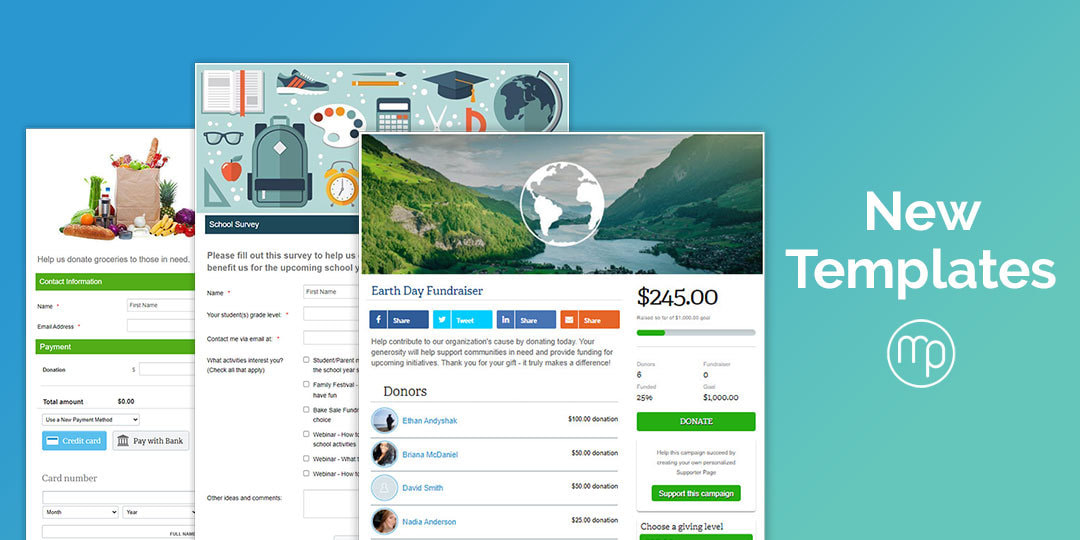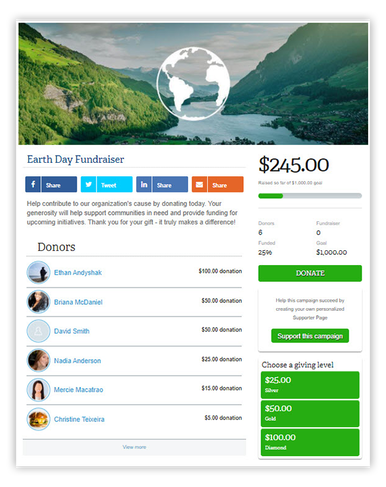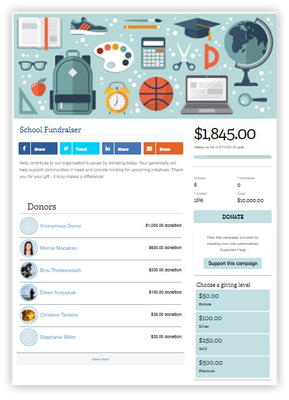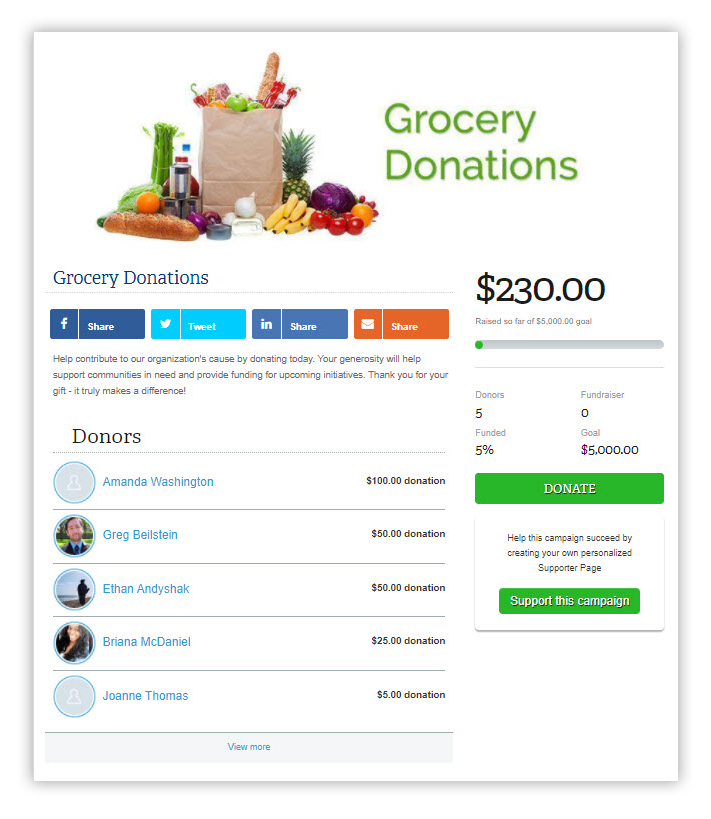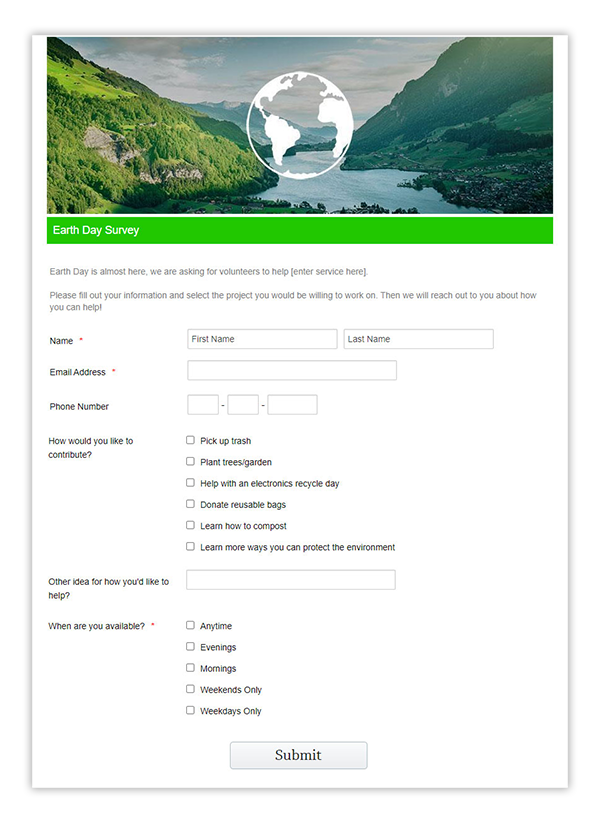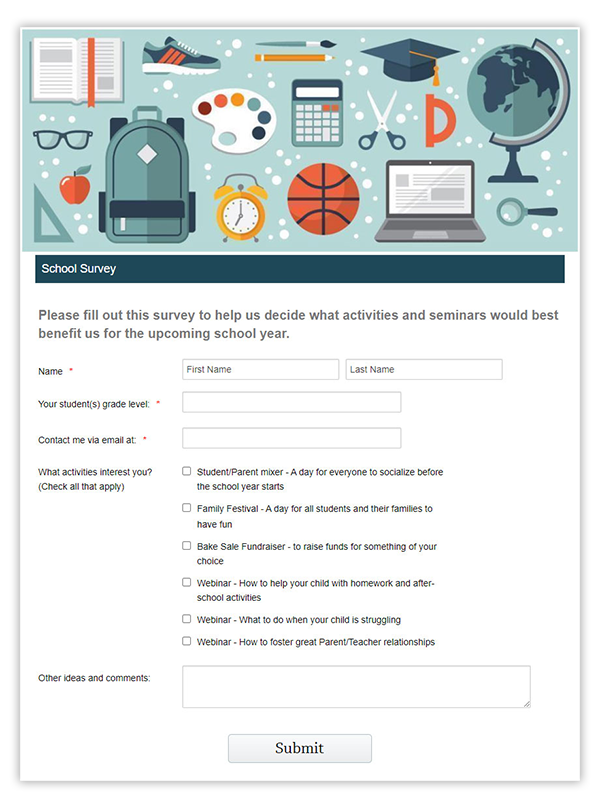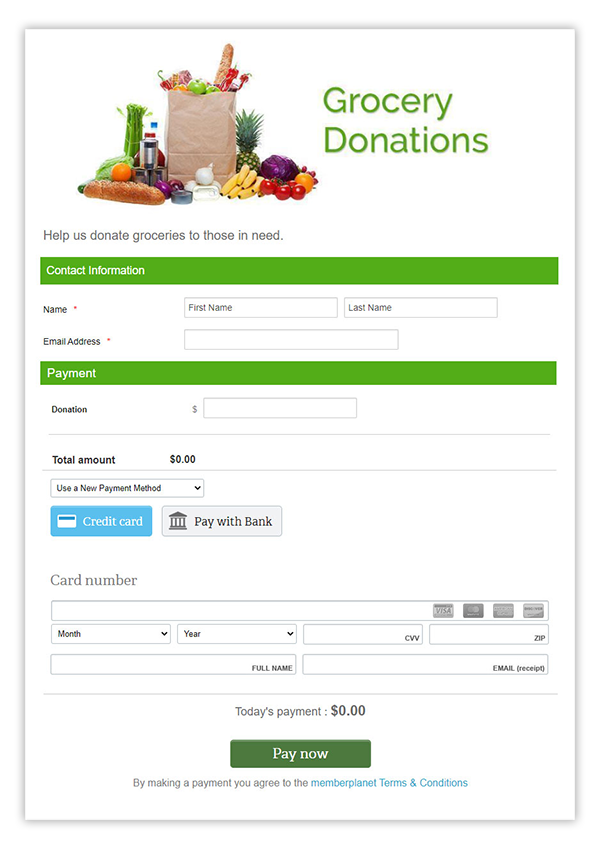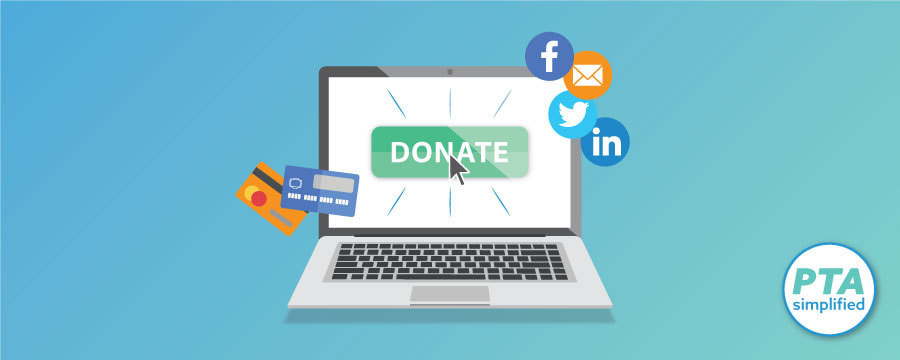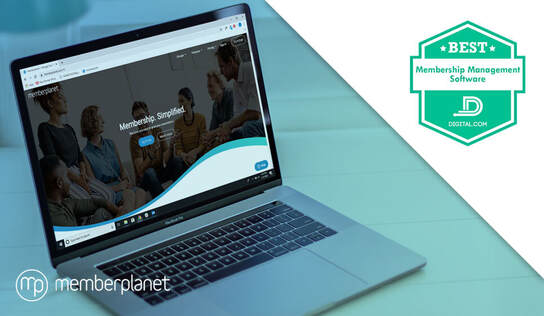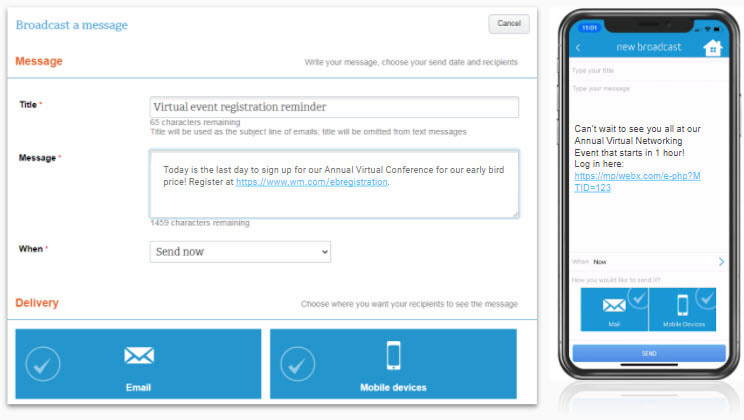|
Launching your online fundraising campaign is quick and easy when you’re working off a template – and we’ve got new ones for you and your organization! Whether you’re leading a local nonprofit, chapter, or national association, we’ve got you covered. Check out templates and fundraising ideas for multiple causes, including Earth Day, food and grocery donations, and school/PTA campaigns.
Looking for survey and payment form templates? Yes, memberplanet has those too!
Donation campaigns:
Ideas:
Templates images (click to view a larger image):
Survey forms:
Ideas:
Payment forms:
Ideas:
Pro Tip: If you are selling items that need to be picked up, set up a payment notification via SMS text. Template image (click to view a larger image):
Related Blogs:
COVID-19 Templates Benefits of Managing School Fundraising Events Online Note: Collecting funds on the memberplanet platform incurs a platform fee and payment processing fee. Please see Pricing for details.
0 Comments
Effective PTA leaders have many duties. They have endless parenting obligations, and must commit to becoming a resource to other parents in the community. PTA leaders focus on fundraising because they firmly believe their altruism will help not just their children, but all the children of that school community. As a PTA leader, you might find it challenging to balance these responsibilities. Take the time to understand the online tools at your disposal, and your local PTA will reap many exciting and lucrative benefits.
Social media reaches more people
The number of social media users is growing exponentially. According to Hootsuite and We Are Social, more than 4 billion people around the world use social media each month since October 2020, which was an increase of more than 12 percent in the prior year.
More than 4 billion people around the world use social media each month.
It makes perfect sense for PTA leaders to consider how using social media can boost fundraising by targeting specific audiences. For example, The Balance Small Business claims that millennials (the first generation who grew up plugged into the internet) prefer online and social giving. Take a look at how connected to technology your PTA members are. Using smartphones have become a way of life for most. Utilize and mobilize your social media presence to spread the word about fundraising events.
Mobile and online payments simplify the process
Offering online and/or mobile payment and donation options do more than just help you broaden your reach. They remove the need for donors to have cash and checks on hand. Accepting online payments leverages today’s tech with potential donors - it’s only a few clicks from decision to completion of payment. That’s why online donation campaigns see more overall dollars collected. It’s not just easy, it’s a familiar process that donors feel innately comfortable with. According to a Cone Communications study, 48 percent of American adults are likely to use an app to make a donation. What are you waiting for? You can broaden your reach (and increase your donations) by using mobile and online payment methods.
Effective imagery and videos improve engagement
Whether you are looking to grab the attention of potential donors, spread the word about a cause, or inspire volunteerism, utilizing images and videos are powerful storytelling tools. Use imagery that appeals to your donors' emotions, and shows the needs for funds and benefits of giving - it beats text-heavy messages.
According to The Guardian, people are more likely to donate to a cause when it means something to them. This is also why crowdfunding and peer-to-peer fundraising are so effective. Use effective imagery and video to help tell your story, and let them feel connected to the cause you want them to support.
Email drives donations
Email is a powerful tool for driving PTA social media presence and donations. Just ask the people behind the M&R Benchmarks Study who found that for every 1,000 fundraising emails delivered, a nonprofit organization raises $45 on average. When you make emails engaging and fun, you might even pick up some email subscribers.
Keeping your email contacts organized in an online platform makes it seamless to communicate with your whole audience and track their responses. You can test and target your messages to specific recipients, and optimize your fundraising efforts to meet your goals every time. Beyond emails, organizing your contacts on the platform into customized distribution lists drives engagement in a specific way most suited to your needs. Set them up to send thank-you messages anytime someone donates, or send donation campaign details to any new contacts. Your options aren’t limitless, they’re better: They’re specifics built exactly for you and your local PTA. By making the most of online tools such as social media, electronic payment options, photo sharing, and email, you can be more successful in your fundraising efforts. memberplanet's integrated platform makes it easy to use these tools, and offers local PTAs an edge that will make managing fundraising events more effective and engaging.
Learn more about fundraising on the memberplanet blog.
PTA Simplified is a series of tips for PTA and PTO leaders to get the most out of a powerful association management system – to manage, engage, and grow their membership all year long.
Updated since original publication on 9/22/2017.
We’re excited to announce that memberplanet received recognition in Digital’s Best Membership Management Software of 2021! Its research team conducted a 40-hour assessment of more than 90 solutions, and the platforms were selected based on core features and customer feedback. (You can read full details in Digital’s press release.)
It is always an honor to be recognized for our mission, which is to simplify membership management. It is our constant focus! We use market best practices and feedback from our clients to refine and augment our platform’s functionality – on a regular basis – so that we can help our partners be even more productive in today’s ever-changing digital landscape.
Our team is also passionate about providing exemplary support to all our partners – associations, nonprofits, PTAs, foundations, chapters, or any other type of organization – as well as coaching their administrative staff. If you’re looking for a powerful association management system (AMS) or all-in-one platform, visit memberplanet.com to learn how we can help you manage members, engage constituents, and grow membership.
About 90 percent of text messages are read within three minutes, and the open rate for SMS text is as high as 98 percent, according to Gartner. This is probably common knowledge if you’re a marketer or communications professional, but those who are in charge of day-to-day membership operations, communications, and events (whether virtual or not) should also take advantage of this.
While there’s no shortage of mass text messaging apps in cyberspace, the main benefit of using an integrated platform is that you get the metrics you need associated with membership. There’s no wasted time in exporting contact lists, uploading to a separate text messaging app, then downloading and filtering data based on opens and responses. A true membership management solution houses all of that functionality in one system, making multi-channel communication more efficient, convenient, and productive.
Group text messaging can be incredibly useful, but it can also be overused. Here are four main guidelines to stick to when deciding whether or not to email or text members or other administrators in your organization.
1. You have an urgent announcement Before you send your mass text message, ask yourself: Is this urgent? The reason SMS open rates are so high is because the majority of people, including your members, have their phones close by. It only takes a few non-urgent messages before they’re annoyed with the frequency of your sends. Just like mass emailing, consumers have the capability to opt out of mass text messaging – so text sparingly and only when there is real urgency. If you think your message can wait to be read, use email. 2. Your message is short Even if you have an urgent message that you need to broadcast, it’s still safe to say the average person doesn’t want to scroll through paragraphs in a text message. A good rule of thumb is keeping within the character count of a Twitter post. You can always send a detailed email, then if necessary, send a text that mentions the subject line and to check the email for full details. 3. You need an immediate response When you are looking for a quick turnaround on responses, text messaging is the way to go. Viable mass text solutions differ from regular text messages and group chat apps – even if you text multiple contacts, only you will receive their responses (unlike those annoying text chain messages). 4. The time is right Lastly, it’s common courtesy to send and schedule texts during regular business hours, unless you’re running a widely publicized event or campaign and your contacts expect messages from your organization. I can’t speak for anyone else, but my Saturday mornings are pretty sacred.
Stick to the best practices above, use common sense, and you’ll be golden. memberplanet’s Broadcast feature lets administrative users send SMS text messages and email simultaneously, from a custom text number (so your members or constituents can tell it’s coming from your organization). You can learn more about this feature and our fully integrated membership management platform by scheduling a demo with our team.
The adage about things changing but staying the same often feels out of date as the world moves faster and faster, and the technology in our hands does more, listens better, speaks, and buzzes without our interference. Still, we need to be reminded daily about a litany of things both large and small. We use everything from checklists and notes to apps and alarms to ensure our tasks aren’t forgotten. Your association’s ongoing success is in part defined by how aware your members are of what is vital and happening within it. These 5 email reminders are crucial to keeping your membership engaged and current with relevant information from your association.
1. Member benefits
Always lead with the what’s-in-it-for-them approach. Emails arrive in an almost constant stream in everyone’s inbox these days, and users get notified on their mobile phones; make sure yours isn’t swiped left into the garbage by sending benefit reminder emails. These tidbits reiterate the value of your association and keep it at the forefront of readers’ minds. Benefit reminder emails can come in the form of a newsletter that includes related membership perks; they can also highlight little known or often unused benefits like access to your association’s trade magazine or a calendar of free members-only events and discounts. 2. Membership renewal reminders This is perhaps the most important email associations should be sending to their members. Renewal dates can be forgotten, or slip by in a person’s busy daily schedule. A renewal email reminder is not only a benefit to members, it also helps improve retention, which is a benefit to your association. Your association management system (AMS) or membership management software should let staff automate and customize renewal reminders so members are only a few clicks from completing the process. It is standard functionality to set up reminders according to rolling renewal periods, frequency of emails, and how many days before renewal each email is sent.
3. Virtual events
Attendance is paramount to more than just the success of a particular event; it’s also vital to the growth of your association. Utilize email reminders to inform constituents of annual conventions and important events on your association’s calendar. Provide registrants with relevant details like webinar start times and the schedule of activities, as well as reminding them of your code of conduct when interacting online and other event-specific information. Event emails can remind constituents of the events they’ve previously RSVP’d to. Your association staff should have the capability to customize and automate email reminders with your event management software so that all registrants receive a personalized notification before the event. 4. Donation campaigns When the task at hand is raising money, awareness is key. Campaign reminders help boost promotion, further spreading your reach while increasing the likelihood of achieving your goal. Take advantage of your member’s social networks by including a campaign link in your reminder email so they can easily share it. After all, they’re your best ambassadors! If your association is a 501(c)(3) organization, you can include your tax ID number among other relevant information to remind members their donations are tax deductible. Association staff should also use their fundraising solution to set up automated thank-you emails that go out after someone donates. It’s a great way to complete the donation circle with members so they feel their effort is appreciated. 5. Industry news Informed members are empowered members. Your association should be a thought leader in its area of focus. Use email reminders to ensure there’s a strong baseline of thought-provoking articles, trending updates, and educational resources sent to your membership. This is a great place to share links to your online magazine or blog articles; you can even include an online form for members to sign up to receive blog or article updates by topic. It’s a wonderful way to share content, videos, virtual event highlights, and research with your entire membership.
Don’t hesitate to take advantage of the power of email reminders. If you keep your members engaged and informed of all your association has to offer, you will continue to achieve its goals. To learn more about an AMS that can simplify the tasks mentioned above, schedule a call with the memberplanet team.
Updated since original publication on 2/6/20.
Great trainers are naturally great leaders. And by definition, great leaders are those who inspire confidence, strength, and optimism. They are the folks who can motivate – not force – their administrators to reach their fullest potential as they ascend to a new role or take on greater responsibilities. And we all know how important a good trainer is during officer or staff transitions.
The term admin can be applied broadly – it can mean your committee heads, officers, or anyone you’ve put in charge of tasks that keep your organization running smoothly, whether it’s an association, chapter, or other type of membership-based group. As far as training the best admins goes, a great trainer/leader uses methods that can be boiled down to a few guiding principles. I call them 5 Keys to Training Your Staff Admins; master these, and your team will be set for success.
1. Demonstrate
For every specific skill or task to be instructed to your team admins, explain first what it is you’re about to share. More importantly, explain why it is important for your organization. How does it work in its specific scope? How does it affect the overall team? It’s important to give a sense of the overall flowchart of the group and the admin’s role within it. “A leader is one who knows the way, goes the way, and shows the way.”
2. Observe
You’ve provided the instructions to light the path. Now have your team show you how to do it. You’ll be able to see if how much they’ve retained from their training, and how well they apply their knowledge and adapt to different situations. Of course, knowing what you know, don’t keep them in the dark. Adjust the course when necessary. Encourage and empathize.
3. Tailor
We are all individuals (maybe some are more like rebels) in the world, and personality will eventually be revealed, especially in the course of training. Make time to discover your admins’ own skills and experience. Do they enjoy a steady pace? Or do they work best at light speed? But be sure to recognize their different ways of learning, and be open to adapt to give each of them the answers they’ll need ongoing.
4. Empower
Grow your staff admins. As they navigate their new role, give them space to make mistakes – that’s how we really learn. Assign a project or task as a test (e.g. an upcoming social event, or a fundraising campaign, or a yearly calendar of projects) and see how they rise to the challenge. Let them own it. If they can construct it, it’s like a rite of passage.
5. Support
Provide support and feedback. Work with each admin to set up short- and long-term goals for themselves and the organization and make sure they know how to use the tools available to them. On the feedback loop, too, show them what’s been done previously by their predecessors. Encourage them to find ways to innovate and improve efficiency while building on past successes and the great work that’s already been done.
Even after they’ve completed their training, seek out your staff admins’ feedback and listen to their perspectives. Learning is a two-way street, and hearing from them will bolster your own knowledge and help you further educate them. When your admins are confident that you as their trainer/leader have their back and their interests at heart, they’ll operate at peak productivity, and they will lead the rest of the organization in the way they’ve been instructed. This is the way to build a lasting team and community. “Without a sense of caring, there can be no sense of community.”
Updated since original publication on 02/12/18.
Are your current methods of virtual engagement helping you reach your membership goals? By promoting the value and benefits of your association’s membership through engagement, you can position yourself to attract new members while also maintaining and interacting with your existing membership base. Here are a few tips to showcase your value and increase your network:
1. Engage on social media
Update your members with upcoming meetings and events while keeping them engaged with polls and surveys to collect feedback. Being present on these platforms also helps potential members preview membership, understand your association’s mission, and see the kind of work you’re doing.
2. Invite potential members to events
It also gives nonmembers a chance to try before they buy – ask questions and see what your association offers before committing to membership. Asking your members to engage nonmembers will give your association the opportunity to grow exponentially.
3. Make an offer they can't refuse
To attract those who had been considering membership but either were not ready to commit or were deterred by the fees, waive application fees for a limited time. Or offer additional perks with an expiration date.
Advertise and announce the offer in your newsletter and on social media so prospects become aware they’re getting a great deal. When you convey a sense of urgency (Ex. Act fast to take advantage of waived membership fees!), your potential members will see more value in joining during this time. You’ll additionally want to make sure your membership benefits are competitive, so as not to deter those who are comparing with other associations.
4. Track and measure your engagement efforts
If it can’t be measured, it can’t be managed. Record metrics of your engagement efforts to gauge your success and find ways to optimize over time. Some things to keep an eye on are email and text message metrics, such as open and clickthrough rates, as well as resulting membership numbers, i.e. renewals and new signups. If you host an event to invite potential members, keep their email addresses to send them offers and other emails to promote membership.
Most marketing and membership software offer standard tracking, but it can be a difficult and time-consuming task to tie your data together if you’re not using the right tools.
Our engagement solutions are fully integrated with a full suite of membership, communication, and event management tools on the memberplanet platform. You and your staff gain actionable insights with real-time reporting and a centralized database of membership for both your members and potential members. Maximize your engagement efforts and get a high-level view your association’s health – contact memberplanet to learn more about how we can help you manage, engage, and grow.
Updated since original publication on 2/20/18.
Here we are again. It’s the time of the year when we have to start setting goals for our organization. And after 2020, a year like no other, 2021 is sure to be interesting.
When it comes to goals, there’s one key question we need to ask ourselves: Can these goals be told in a story? You’ve heard the adage: Facts tell but stories sell. It’s true in marketing and advertising. It’s equally true when it comes to setting goals for an organization. That’s because setting a goal is just the first step in the process. After we’ve developed goals for our organization, we have to sell it to the troops, and we need to do it convincingly. If 2020 forced us to prioritize what was most important to us in life, then our goals for 2021 must be endeavors worth pursuing. And that comes down to good communication skills. It’s a fact. People make decisions based on emotions rather than logic. Whether we’re trying to accomplish a specific task or raise funds, we have to be able to communicate our goals clearly and emotionally to our members and constituents. We have to bring people on board. Rally our members to our cause and lend their support. Y’know, herd cats. (If you've ever tried that, you know it's very hard to do.)
If we want others to join us on our quest, we have to be able to show our members why ours is a worthy cause. The more enthusiasm we can generate about our goal, the easier it will be to accomplish.
How do we inspire the type of passion that we want from members, the type of enthusiasm that’s going to carry us through good times and bad until we cross our goal line? With a good story. How true it was when "Game of Thrones"' Tyrion Lannister said, "There’s nothing more powerful in the world than a good story. Nothing can stop it. No enemy can defeat it." Whether our objective is a one-time, standalone goal (think sponsoring a clothing drive for natural disaster victims) or part of a larger, long-term initiative or mission statement (think serving the needs of children with disabilities) a good narrative helps us communicate more persuasively with our members. The more we can connect with people on an emotional level, rather than a purely rational one, the more excitement we’ll generate for our cause, the faster we’ll achieve it … and the invested everyone will feel. According to Joseph Campbell, one of the world’s foremost authorities on the significance of myths and storytelling, “Everything starts with a story.” “Everything starts with a story.” – Joseph Campbell
Great stories touch us on an emotional level and teach us universal truths about human conduct. Think about it: Every story we’ve ever been told has had a point to it, a theme. The theme is a lesson about life. Something to which humans should aspire. A goal.
Consider your goals from a storyteller’s perspective As we set goals for our organization, let’s take time to consider these goals, one by one, from a storyteller’s perspective. Every story has a hero. In our case, the hero is our organization. Every story has a conflict. There’s something wrong that needs to be fixed. Perhaps we’re trying to raise money to send aid to families with children adversely affected by COVID-19. The conflict is, some children don’t have means to basic necessities, and our organization wants to fix that. Every story also has a resolution. In our case, it’s our objective. Accomplishing our goal will resolve the issue at hand and bring the story to its close. 
Can we incorporate these elements into our goal and use them to weave a compelling story that captivates our members? The truth is, people have a fundamental need to connect with something larger than themselves.
A good story about our organization and its goals will help bring more people into our tent and enfold them into its larger mission. As organizational leaders, we must be able to find the narrative within our cause, capitalize on our natural storytelling strengths, and express our goal with clarity, creativity and conviction.
Embrace the conflict
Oh, yeah. There’s one more thing to remember, too. By definition, great stories involve a journey that is rarely easy. In fact, as is often the case, the more conflict, the better the story. So let’s approach our goals with the same mindset. It won’t be easy to achieve (and, if it is, perhaps we’ve set the bar too low). In most narratives, the hero has a long-term goal that is fed by a series of short-term goals. Accomplishing our short-term goals are the means by which we eventually achieve our ultimate mission. We can think about our organizational goals the same way. Our long-term goal is usually provided in our mission statement. It is our story’s theme. As you know, our long-term mission is achievable, measurable and time specific.
Our mission (not an impossible one) then must be broken down into shorter-term functions and operational initiatives. Short-term goals are great ways to identify specific functions that need to be undertaken, and offer measurable results that allow us to chart our progress, feel a regular and much-needed sense of accomplishment, and move us further along the narrative toward our ultimate goal.
And it’s that sense of accomplishment – of fighting for a cause, righting a wrong, creating a better tomorrow – that creates the pride and emotional connection that will keep our protagonists (members) coming back for more. So when it comes time to set a goal for your organization, be bold, creative and inspiring. Identify the story inherent within your mission and use it to assemble your short- and long-term goals. In the end, the goals you set today will become the stories your members live tomorrow. Let’s make them exciting ones!
Have a goal in mind? Our event and donation sites (templates included!) make it easy to tell your story.
Updated since original publication on 12/16/16.
You’re put in charge. Now what? Group leader transitions are not without their complications, but that doesn’t mean they have to be difficult. By following a few key steps, you can ensure a smooth transition (think smoothie, not boba) that is beneficial for the entire organization. The transition period is the time for new admins to prepare for their position while outgoing officers gain a sense of closure as they move on from a job well done. The goal is to maintain a sense of seamlessness and continue the great work that’s already been completed. Remember, you’re not starting from scratch. When done right, you avoid setbacks (which might feel like a chunk of fruit stuck in your straw).We’ve put together three pro tips for pulling off the ol’ switcheroo with minimal disruption to your organization. 1. Maximize your training Access to information is critical for the continued success of the organization and the potential achievements of the incoming officer. They say teamwork makes the dream work, so make sure new and old leaders come together as a unit to make the transition easier and more effective. Maximize the opportunity to learn from the outgoing officer by asking the right questions during the training period. Author and business mentor Michael Hyatt identified 20 key questions to ask other leaders to bolster your own skill set. Here are some key topics to inquire about during the transition process:
Additionally, reviewing goals and objectives from previous terms allows transitioning admins or group leaders to update themselves on the progress of those goals, so they have a reference point for the upcoming term. The former officer should provide a status report on ongoing projects as well as current budget and financial records. To help you build upon the work that’s already done, check out the reports section on the platform, which provides a history of your group’s transactions. You can also see tracking for emails, event sites, and donation campaigns. 2. Make a great first impression We all know that first impressions matter, so this transition period is the time to showcase yourself to the group. Membership management software is a helpful tool because it lets you access current membership information and reach out to the entire organization simply and efficiently. Use it to send a group email to introduce yourself and let members know about the transition process, upcoming meetings, and any changes the new administration will be making to its agenda. You can target your email to specific member levels for a more personalized message, as well as use the Smart Lists feature to segment your distribution lists by variable data. 3. Be prepared to prioritize An incoming leader can get overwhelmed with information overload, so being organized is essential. Updating lists and prioritizing tasks can make the early days of transition less stressful. Your organization probably already has a list of essential documents you’ll need to get started, but here are some of the basics you don’t want to overlook during the process.
Online document storage is available on the platform to upload documents that can be shared with all your admins. If you’re a new admin user, simply check document storage in your admin portal to see what’s already been uploaded.
Once you have obtained and sorted through these documents, you'll be able to focus your efforts on the most pressing issues as a new leader for your organization. Uncle Ben (of Spider-Man fame, not the rice) said, “With great power comes great responsibility.” You don’t need to be a superhero to learn the value of this lesson. “With great power comes great responsibility.” As a group leader, you set the tone for the entire organization. It’s important that you stay up to the task by being prepared and making the most of the officer transition process. Maximize the resources that are available to you and build upon the wisdom of past leaders and current colleagues. Orchestrating a successful transition is your first task as a leader, so make it count! By keeping important documents, reports, contacts, and everything else in one spot, memberplanet simplifies leadership and officer transition. Log in to check it out. Updated since original publication on 12/11/17.
It’s hard to believe that the holiday season is quickly approaching, isn’t it? The first sighting of snow-covered décor or lit up trees means that giving season is upon us! There is one major event that kicks off holiday giving – Giving Tuesday. Celebrated on the Tuesday following Thanksgiving, Giving Tuesday 2020 takes place on December 1.
In 2020, the COVID-19 pandemic caused an unprecedented need, and Giving Tuesday Now launched on May 5 as an emergency response. Just take a look at these amazing stats:
The pandemic has already had major effects on the way people give in 2020, and one can surmise it will continue to change the holiday giving season. As awareness of the day continues to grow each year, so do its benefits for charitable organizations. Giving Tuesday has become a global event, but you don’t need to be a national or multi-tiered organization to participate. Here are three steps even a local nonprofit can take to prepare for the main event.
Step 1: Set your Giving Tuesday fundraising goals
An important part of preparing for Giving Tuesday is setting your fundraising goals. When setting your goals, you can consider the following:
Remember, the more prepared you are in determining your goals, the easier it will be for you to nail down your message when you’re ready to share your goals and grow community involvement!
Step 2: Fire up your fundraising campaign
You have a million ways these days to approach promoting your donation campaign. You can go the chestnuts-roasting-on-an-open-fire approach, which is kind of a slow burn at first, and then switch to fireworks finale mode, an all-at-once effort, toward the end.
Whatever approach you decide on, take advantage of email and social media – two powerful marketing platforms.
Mobilizing volunteer efforts is another strategy that spreads awareness throughout your local community and celebrate giving. The holiday giving season can mean giving one’s time or donating goods – not just funds. By inviting donors, employees, and members of the local community to your event, you can attract attention to your cause.
Step 3: Make donating easy
In business, a best practice is to make it easy for customers to give you their money. The same applies to your donors. Always give them the options to donate when they want and how they want. By offering the option to donate electronically, your supporters can make secured donations conveniently from a website or mobile device, whenever they want, even if they’re thousands of miles away. You can still accept cash or check, but you’re not limiting your fundraising by only accepting those forms of donations.
Nonprofits that offer online giving also widen the donor net and grow overall fundraising revenue. By setting up a way to process funds electronically, you can also offer donors the option to pay by recurring or installment payments. Recurring payment options are a great fit for those who want to contribute weekly, monthly, or quarterly throughout the year. Installment payments give donors the convenience of breaking up a large sum of money (which they may not have considered giving all at once) into multiple payments of their choosing.
By using these key steps to prep for Giving Tuesday, your organization will not only be a part of a growing movement, it will also give you the chance to celebrate the success that your charitable efforts deliver to your local community. Ready to get started? Log in, create a donation campaign, and choose from multiple templates, including Giving Tuesday and other seasonal occasions.
Updated since original publication on 10/23/17.
|
